The Italian tradition of a St. Joseph Table is a popular devotion for the Feast of St. Joseph.
The “Tavola di San Giuseppe” (“St. Joseph’s Table” or “St. Joseph’s Altar”) originated in Sicily, which claims St. Joseph as its patron. It is practiced on March 19, the feast of St. Joseph. March 19 is also Father’s Day in Italy, which is fitting as St. Joseph was the foster father of Jesus.
This celebration featuring a makeshift shrine is a symbolic “thank you” and renewal of the Sicilian people’s devotion to St. Joseph.
It is a shared or communal celebration, in which the riches of food are given as alms to the poor and no one can be turned away. It has three aspects: veneration, special recognition of St. Joseph during Mass and at the “table”; the table, both a kind of “altar of reverence” and a communal celebration; and the poor, with the intention that the gathered food will help people in need.
Here’s how to set up your own St. Joseph Table at home or at your parish:

STEP 1: Choose a date and invite guests. If March 19 is not possible, celebrating a day or two before or afterwards is OK. It is ideal to host the celebration after Mass. Invite guests, especially children to dress up and play the parts of the Holy Family, the Apostles and angels. Guests should bring decorations or food items for the table.
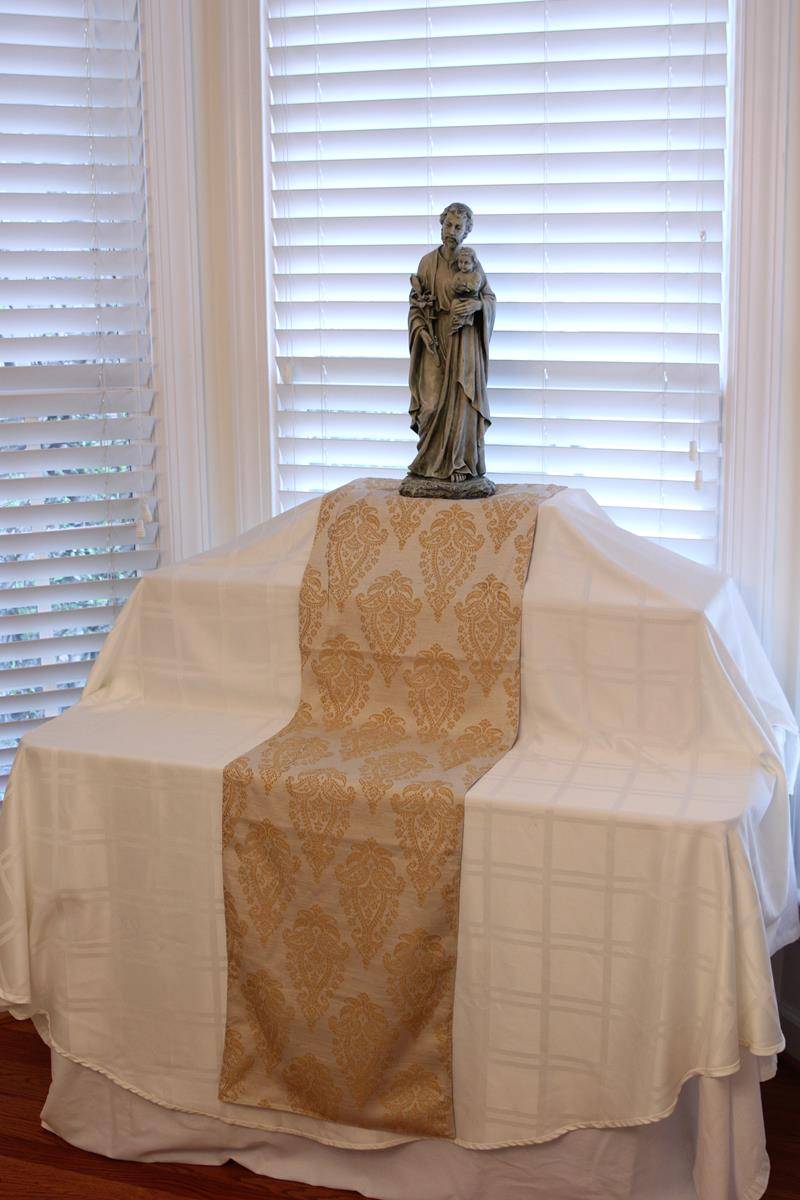
STEP 2: Set up the table. Place a table in a prominent location of your home or church. On the table, arrange at least two display tiers using durable boxes or small shelves. (The three tiers represent the Holy Trinity, and the ascent from earth to heaven.) Cover the table and tiers with a white tablecloth.
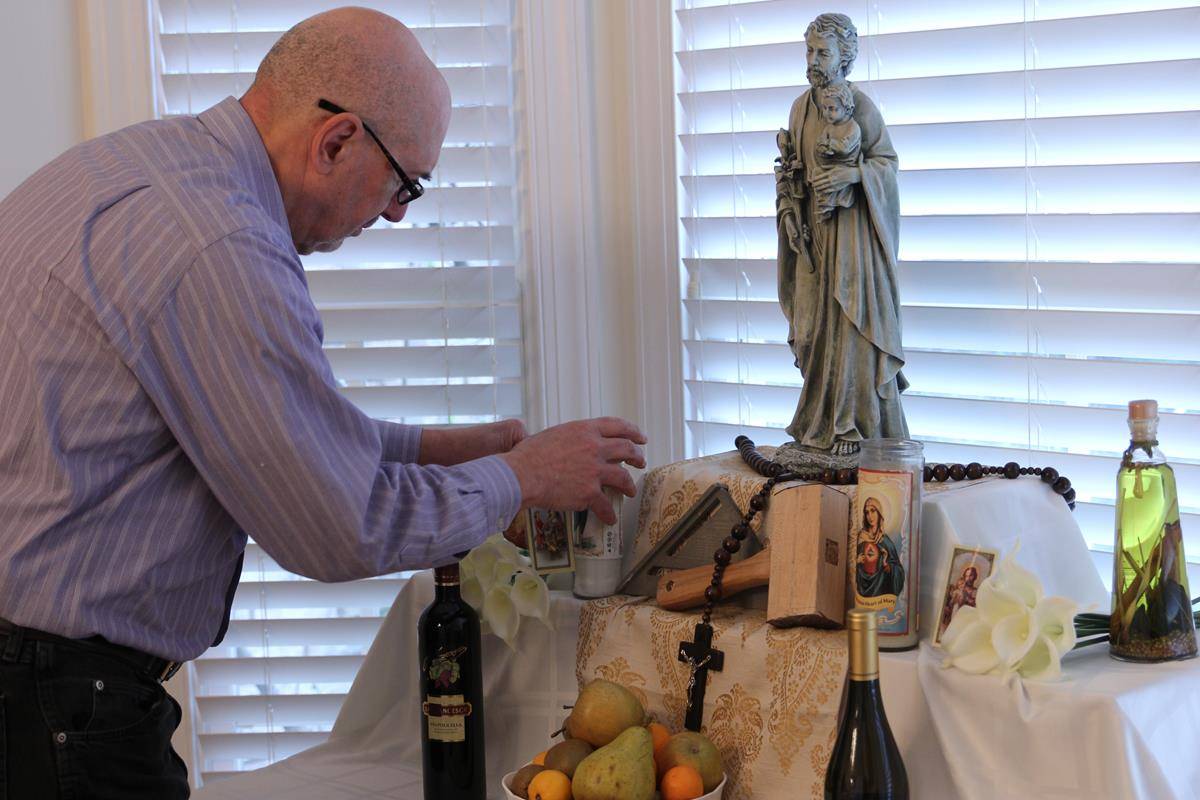 STEP 3: Decorate the table. Place a statue of St. Joseph on the top tier. On the other tiers, display flowers (white lilies, in particular), candles, statues, rosaries and holy cards. The setup should be solemn and festive – use your imagination! Vigil lights of green, brown and yellow (representing St. Joseph’s clothing) can be placed all around, and the table can be surrounded by palms reminiscent of the Holy Land.
STEP 3: Decorate the table. Place a statue of St. Joseph on the top tier. On the other tiers, display flowers (white lilies, in particular), candles, statues, rosaries and holy cards. The setup should be solemn and festive – use your imagination! Vigil lights of green, brown and yellow (representing St. Joseph’s clothing) can be placed all around, and the table can be surrounded by palms reminiscent of the Holy Land.
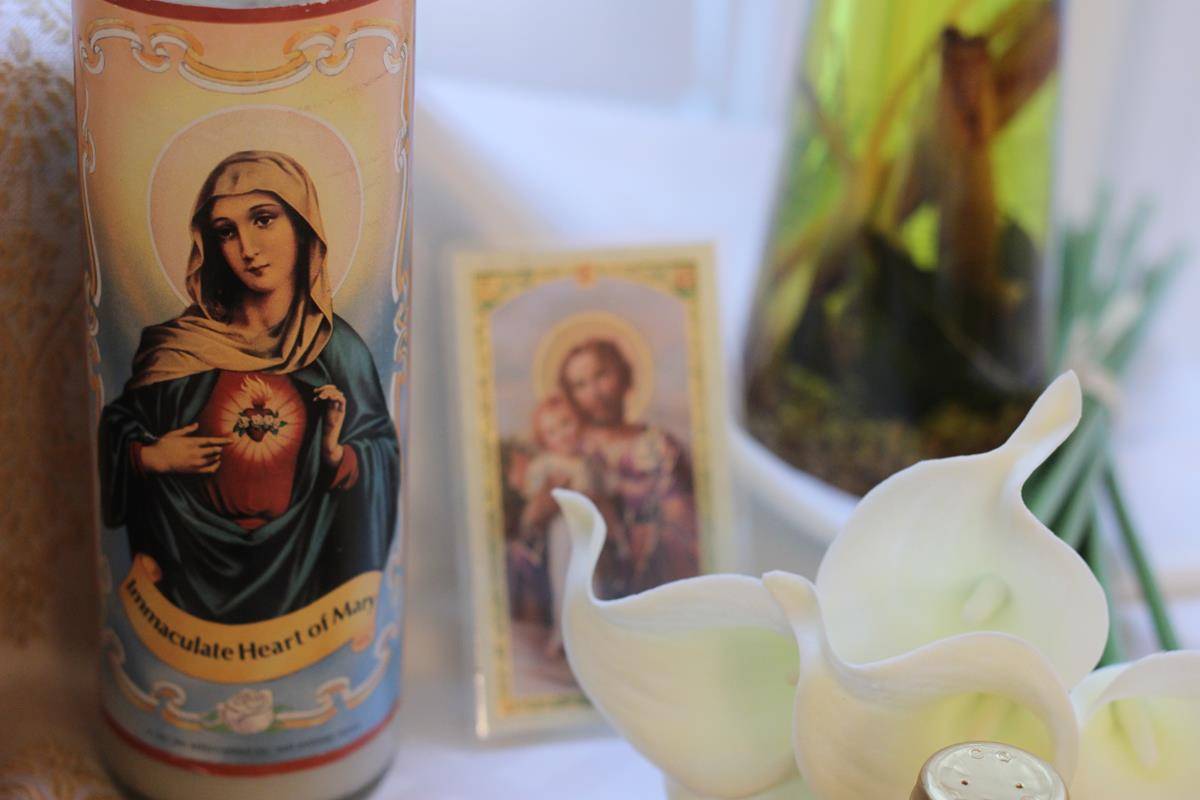
STEP 4: Set out a basket to collect prayer intentions and alms for the poor. You might collect canned goods for a food pantry or have a cash donation basket.
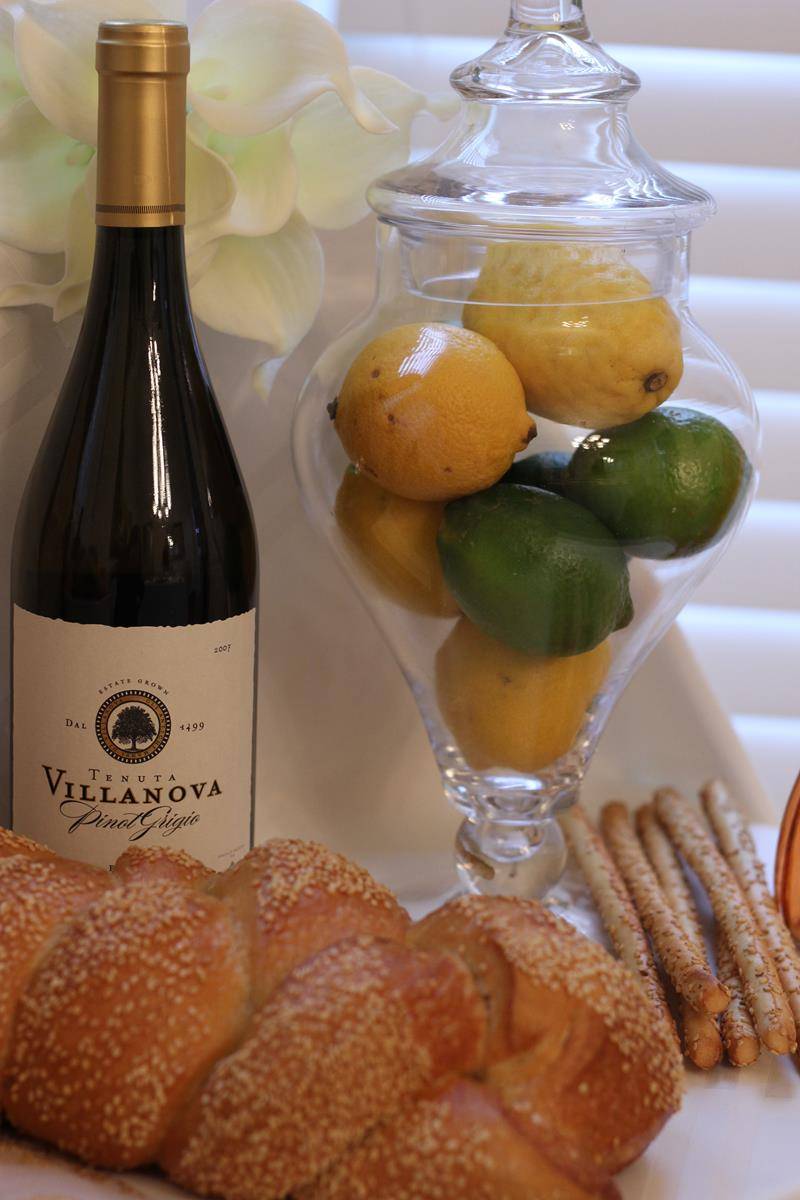
STEP 5: Prepare the menu. One traditional main dish in Sicily is “Carpenter’s Pasta” – pasta made with bread crumbs sautéed in butter to resemble sawdust – but you can include fish, soups or other pasta. Cheese isn’t used, symbolic of the food shortage experienced in the origin legend of the tradition. Sesame-coated artisan breads in symbolic shapes are a key centerpiece of the table and the menu. Don’t forget to include dessert: cakes, biscotti and cookies embellished with almonds are common. For menu ideas, go to www.yearofstjoseph.org.
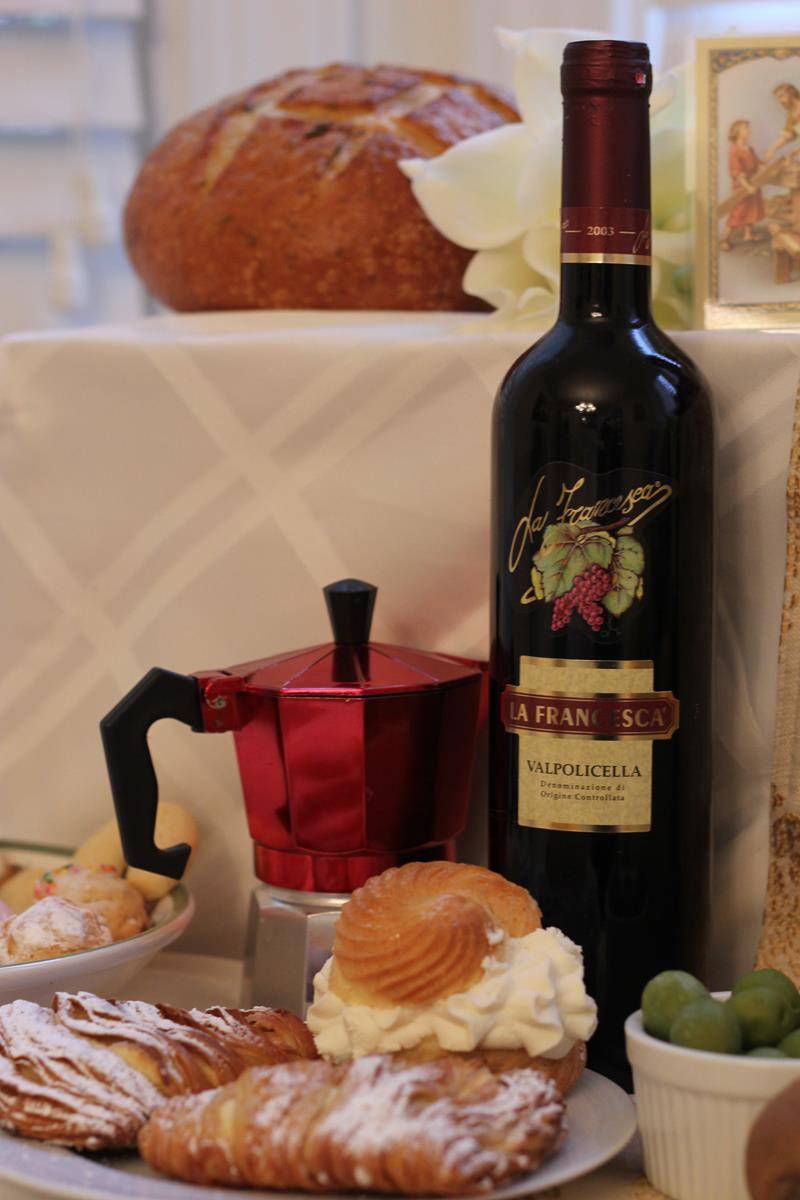
STEP 6: Gather and place specific foods on the table. Special breads, fruits, vegetables, baked goods, pasta, wine and olives are all traditional items found on a St. Joseph’s Table. But as it is Lent, omit any meats and cheeses. Arriving guests should place their items on or around the table.
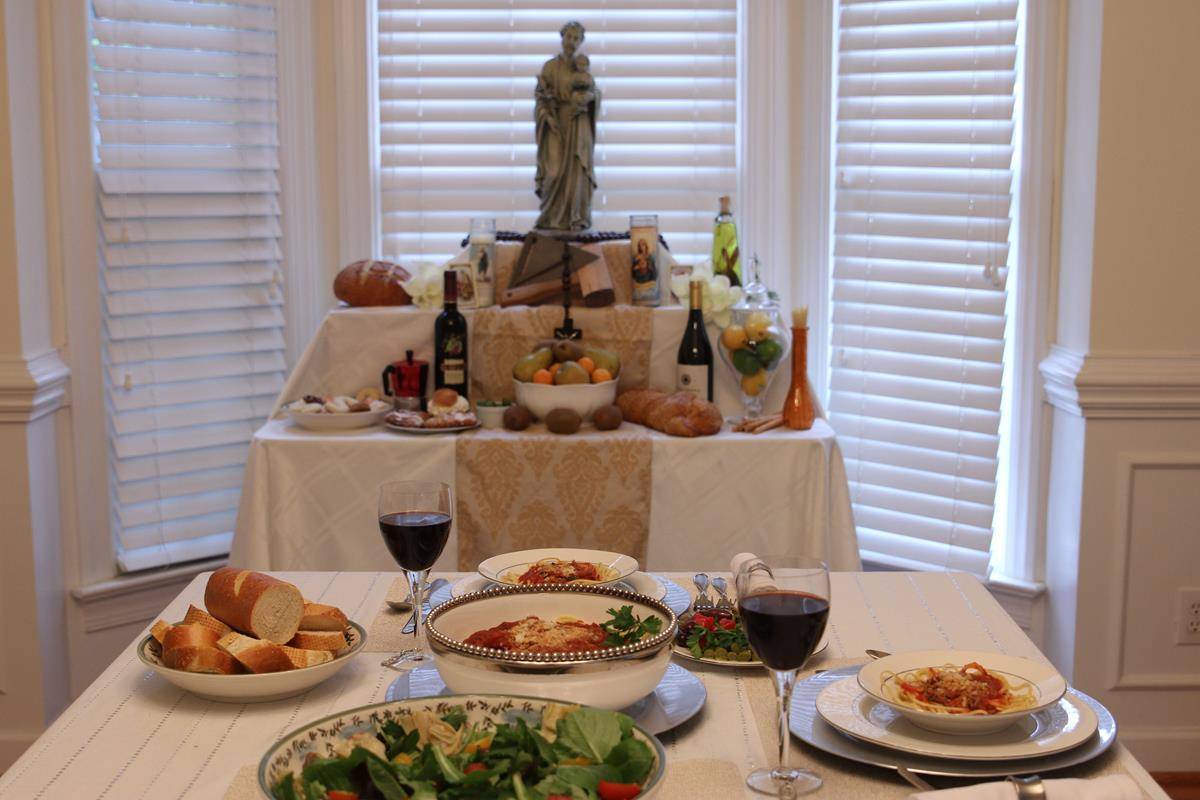
STEP 7: Bless the St. Joseph Table. Before or at the start of your celebration, invite a priest or deacon to bless your table, or pray together as a family.
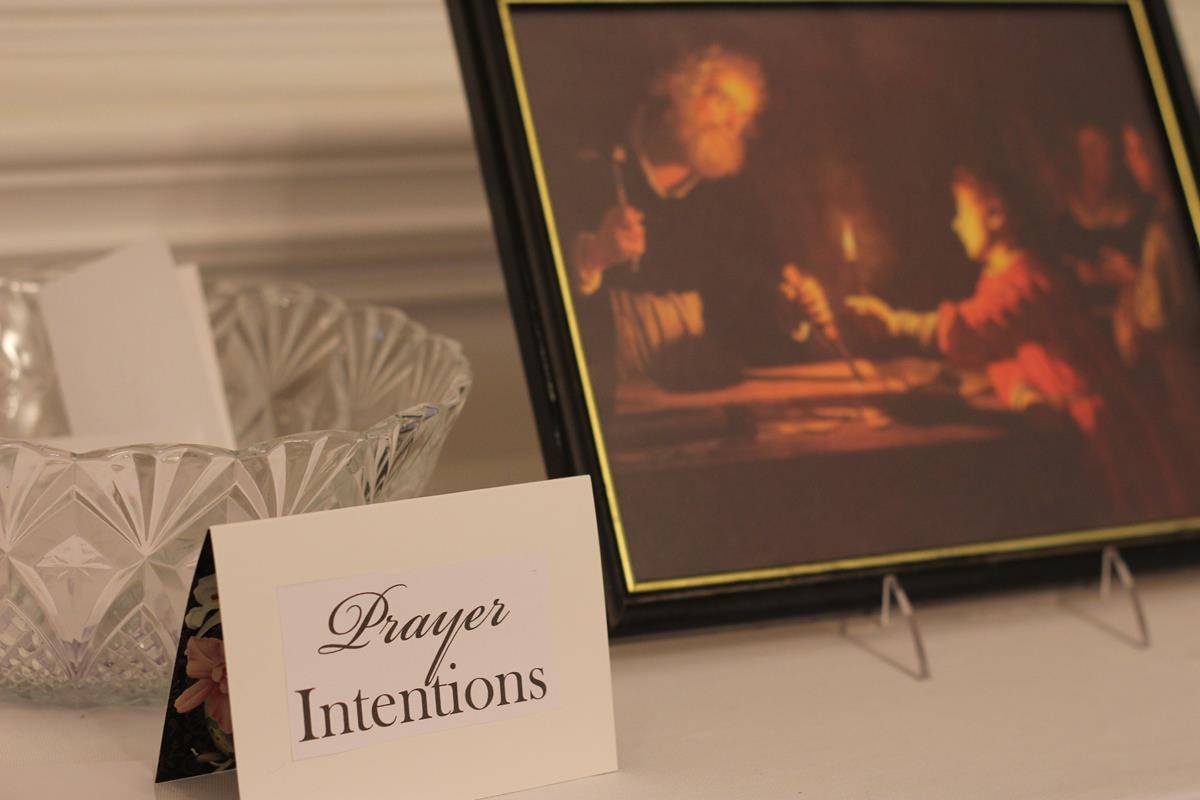
STEP 8: Eat. The three children representing the Holy Family eat first, and they sit at a small table reserved just for them. Food is served buffet style.
STEP 9: Pray. After the meal, pray together as a group, seeking St. Joseph’s intercession. Pray the Litany to St. Joseph or use the diocese’s St. Joseph Prayer Book for other ideas. To end the celebration, offer guests a small gift such as a St. Joseph holy card. When possible, deliver the items collected for the poor to conclude the devotion.
— CatholicNewsHerald.. www.yearofstjoseph.org and Tom Sperrazzo contributed.
Learn more
For detailed information about the tradition and the setting of the St. Joseph’s Table, go online to the Year of St. Joseph website at www.yearofstjoseph.org/devotions/st-joseph-table.
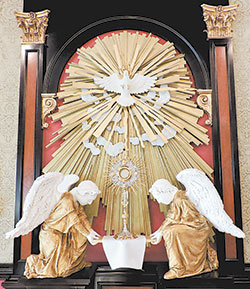 Eucharistic Adoration is the adoration of Jesus Christ present in the Holy Eucharist. In the many churches that have this adoration, the Eucharist is displayed in a special holder called a monstrance, and people come to pray and worship Jesus continually throughout the day and often the night.
Eucharistic Adoration is the adoration of Jesus Christ present in the Holy Eucharist. In the many churches that have this adoration, the Eucharist is displayed in a special holder called a monstrance, and people come to pray and worship Jesus continually throughout the day and often the night.
Christ’s great love for us was shown when He was crucified on the cross to pay the penalty for our sins and give us eternal life. He loves us without limit, and offers Himself to us in the Holy Sacrament of the Eucharist.
The worship and custody of the Holy Eucharist, independently of Mass and Holy Communion, can be traced to post-apostolic times. St. Justin, writing in his Apology around the year 150, says that deacons were appointed to carry the Blessed Sacrament to those who were absent from the liturgy. The young St. Tarsisius was taken captive and put to death while carrying the consecrated Species on his person. St. Eudocia, martyred under Trajan, was first permitted to visit her oratory and remove a particle of the Host which she took with her to prison. What appears to be the first explicit reference to a tabernacle occurs in the Apostolic Constitutions, compiled towards the end of the fourth century, which provided that “deacons should take the remaining particles of the Sacred Species and place them in the tabernacle.”
Implicit in these and similar provisions was the Church’s constant belief in the Real Eucharistic Presence of Christ in the Blessed Sacrament. Thus, in the words of St. Augustine, “No one eats that flesh without first adoring it” (“Expositions on the Psalms,” 98:9). It was on this doctrinal basis that the cult of adoring the Eucharist was founded and gradually developed as something distinct from the Sacrifice of the Mass. At the Council of Trent, Protestants were condemned for denying that the Eucharist is at once a sacrifice and a sacrament; that it differs from other sacraments in not only producing grace “ex opere operato Christi” (deriving their power from Christ’s work), but containing in a permanent manner the Author of grace Himself.
In his 1965 encyclical “Mysterium Fidei,” Pope Paul VI wrote, “The Catholic Church has always devoutly guarded as a most precious treasure the mystery of faith, that is the ineffable gift of the Eucharist which she received from Christ her Spouse as a pledge of His immense love, and during the Second Vatican Council in a new and solemn demonstration she professed her faith and veneration for this mystery...
“No one can fail to understand that the Divine Eucharist bestows upon the Christian people an incomparable dignity. Not only while the sacrifice is offered and the sacrament is received, but as long as the Eucharist is kept in our churches and oratories, Christ is truly the Emmanuel, that is, ‘God with us.’ Day and night He is in our midst, He dwells with us, full of grace and truth. He restores morality, nourishes, virtues, consoles the afflicted, strengthens the weak. He proposes His own example to those who come to Him that all may learn to be, like Himself, meek and humble of heart and to seek not their own interests but those of God.”
Adoration means coming before the Real Presence of the Lord in the Eucharist. But what does that mean? What, or better who, is the reality of which we speak when we talk about the Real Presence?
This reality, as the Church has solemnly defined the truth for the faithful, is the “totus Christus,” the whole Christ: body and blood, soul and divinity. This is not a rhetorical expression nor a verse of poetry. It is an article of the undivided Roman Catholic faith.
There can be no doubt what the faithful are told when they are told to believe in this mystery. Once the words of consecration have been pronounced by a validly ordained priest, what used to be bread and wine are no longer bread and wine. Only the appearances or, rather, only the external physical properties of the former elements, remain. There is now on the altar Jesus Christ, true God and true man, full God and full man.
Does this mean that Jesus is present in the Eucharist? Yes. Is it Jesus in His divine nature? Yes. Is it Jesus in His human nature? Yes. But if Jesus in the Eucharist is really and truly present, is He there with all that makes Him not only man, but makes Him this man? Yes. After all, when God assumed human nature, He assumed this nature as a particular single human being. The divine Person of the Son of God did not merely in some abstract sense become human. He became a definite, historically specific human being.
Thus in the Eucharist is present the Jesus of history: the one who was conceived of His mother Mary at Nazareth; who was born in a stable at Bethlehem; who lived for 30 years in Palestine; and who walked and talked and wept and slept and ate and drank; who shed real red blood on the cross and who rose from the grave, and after His resurrection had the incredulous disciples put their fingers into His pierced side.
When, then, we speak of the Real Presence we imply that part of this reality, which is Christ, is the heart of flesh and blood that every human being has and also Christ has in the glorified body He now possesses since the resurrection.
Note what we are saying. We are affirming that the Sacred Heart of Jesus is not only a historical memory, as recorded by St. John when he tells us that the sacred side of the Savior was pierced on Calvary. Nor are we saying merely that, rising from the dead, Christ is now at the right hand of His heavenly Father in body and soul and therefore also with His human heart. Nor are we saying simply that in the Eucharist is some sort of abstract memorial of the real Christ, who is actually in heaven and no longer on earth. No; we profess on faith that Jesus is now simultaneously both in heaven and on earth; that He truly ascended into heaven and is truly still on earth; that although He left us visibly He is with us really.
This means that the heart of Christ is in our midst, because Jesus is in our midst. He is the same Jesus in heaven and on earth. So He must be present here with His Sacred Heart of flesh, living and beating in the bosom of a living human being.
He is present with His Sacred Heart, at once human and divine: human because He has a genuine human nature, like ours in all things but sin, and a truly divine nature, like that of the Father, with whom He is one God, in the unity of the Holy Spirit.
But that is not all. We know that the heart of Christ is more than just a physical organ of His human body. It is also the symbol of God’s love for the human race, and, indeed, of the eternal love (that obtains) within the Blessed Trinity.
The important aspect of this is the fact that we have in the Holy Eucharist not only the physical Christ in His human and divine natures and therefore His heart of flesh substantially united to the Word of God. We have in the Eucharist the effective means by which we can show our love for God, since it is not just our own affections when we unite them with the heart of the Eucharistic Christ. It is His affections joined with ours. His love elevates ours, and ours as a consequence is raised to a participation in the divinity.
But more than that. By our use of the Eucharist, that is, by our celebrating the Eucharistic Liturgy and by our reception of the heart of Christ in Holy Communion, we receive an increase of the supernatural virtue of charity. We are thus empowered to love God more than we would ever be able to do otherwise, especially by loving the people whom He graciously – though often painfully – places into our lives.
Whatever else the heart symbolizes, it is the world’s most expressive sign of outgoing charity.
It is precisely here that the Holy Eucharist supplies what we could never do by ourselves: loving others with total self-sacrifice. We must be animated by the light and strength that comes from the heart of Jesus Christ. If, as He said, “without me you can do nothing,” it is certainly impossible to give ourselves to others, tirelessly and patiently and continually, in a word, heartily, unless His grace gives us the power to do so.
And where does His grace come from? From the depths of His divine heart, present in the Eucharist, offered daily for us on the altar and available to us always in the sacrament of Holy Communion.
— Jesuit Father John A. Hardon
At www.therealpresence.org: Read about the history and miracles associated with Eucharistic Adoration, get resources for introducing
children to Adoration, find lots of tips on how to pray a Holy Hour, and learn more about practices such as the Forty Hours Devotion and the First Friday Devotion
Spend time with Our Lord
The Diocese of Charlotte is blessed to have Perpetual Adoration of the Blessed Sacrament offered in five locations. All of the faithful, of any age, are invited to participate! Stop by anytime or sign up for a regular Holy Hour:
BELMONT
Belmont Abbey College’s St. Joseph Perpetual Adoration Chapel, 100 Belmont-Mt. Holly Road
Margaret Fox 704-648-8947
Details: www.belmontabbeycollege.edu/about/community
CHARLOTTE
St. Gabriel Church, 3016 Providence Road
Estelle Wisneski 704-364-9568
HICKORY
St. Aloysius Church’s Immaculate Heart of Mary Perpetual Adoration Chapel, 921 2nd St. N.E.
Karen Sadlowski 828-308-5454
Details: www.staloysiushickory.org/perpetual-adoration
HIGH POINT
Pennybyrn at Maryfield Perpetual Eucharistic Adoration Chapel, 1315 Greensboro Road
Edna Corrigan 336-324-4366
Details: www.maryfieldeucharistic.org
HUNTERSVILLE
St. Mark Church’s Monsignor Bellow Perpetual Adoration Chapel (located in the Monsignor Joseph A. Kerin Family Center), 14740 Stumptown Road
Mary Sink 704-892-5107 or email This email address is being protected from spambots. You need JavaScript enabled to view it.
Details: www.stmarknc.org/adoration






